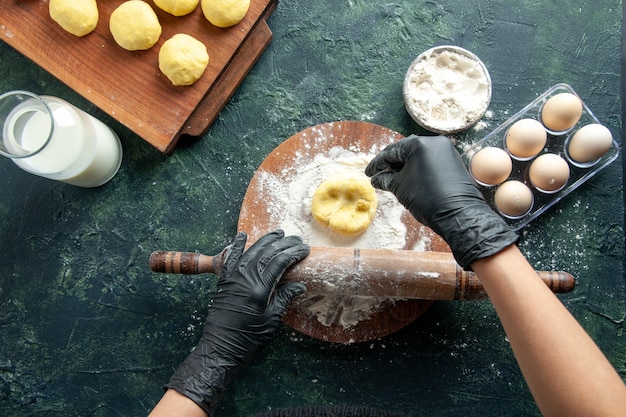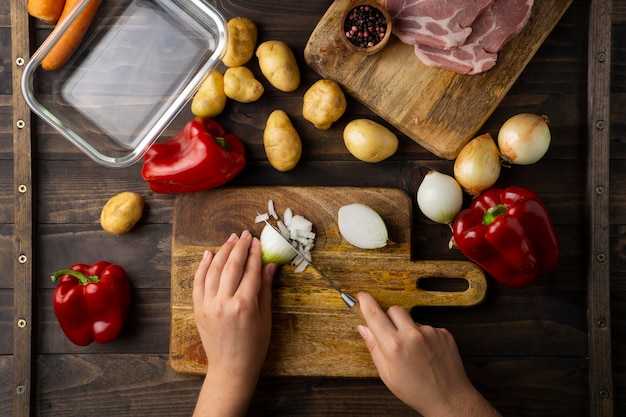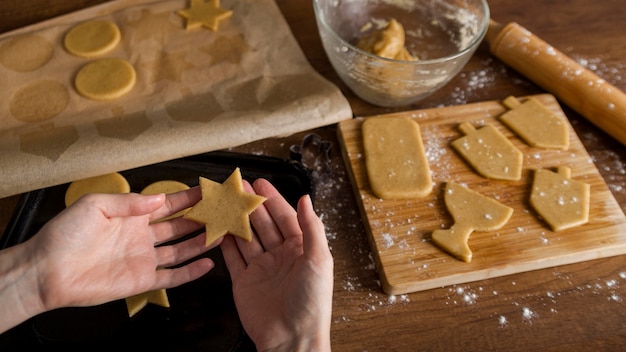(Part 1) choosing the right potato

flour potatoes
These are high in starch and have a fluffy, crumbly texture when cooked. They're perfect for dishes where you want that creamy, melt-in-your-mouth goodness.- mashed potatoes: The fluffy texture makes them ideal for whipping up creamy mashed potatoes that are sure to impress.
- Roasting: They hold their shape beautifully, resulting in crispy edges and fluffy interiors.
- Baking: They’re excellent for potato gratins and other baked potato dishes where you want a firm, but not dense, texture.
Popular floury potato varieties include:
- king edward: A classic choice for its versatility and creamy texture. I often use them for both mash and roasts.
- maris piper: A dependable potato for roasts, chips (fries), and mash. Always a good option when you're unsure what to use.
- Desiree: A slightly sweeter potato with a good, fluffy texture. Perfect for baked potatoes or wedges.
waxy potatoes
Waxy potatoes, on the other hand, are lower in starch and hold their shape much better. They have a firm, smooth, and waxy texture that makes them great for dishes where you want to retain their shape.- Salads: Their firmness keeps them from disintegrating in a salad. They add a lovely bite and texture to the dish.
- boiled potatoes: They hold their shape and are excellent for adding to stews and soups. They absorb the flavours of the broth beautifully.
- potato pancakes: Their firm texture makes them ideal for pan-frying. They crisp up beautifully and hold their shape while cooking.
Popular waxy potato varieties include:
- Charlotte: A dependable choice for salads and boiled potatoes. They hold their shape well and have a delicate flavour.
- New Potatoes: Small, young potatoes with a delicate, waxy texture. Perfect for salads, boiled dishes, or even roasting whole.
- Red Bliss: A beautiful red-skinned potato with a smooth, waxy texture. They are great for salads, boiled potatoes, or even potato pancakes.
(Part 2) Preparing Your Potatoes

Washing and Scrubbing
The first rule of potato preparation? Get rid of any dirt or debris! I always give my potatoes a good scrub with a vegetable brush or a clean sponge. Don’t be afraid to get a bit rough – you want to ensure they're clean.If your potatoes are particularly dirty, you can soak them in cold water for a few minutes before scrubbing. This helps loosen any stubborn dirt and makes the scrubbing process easier.
Peeling or Not Peeling?
This is a matter of personal preference. Sometimes, I leave the skin on for extra flavour and nutrients. The skin contains fibre and other beneficial nutrients that are often discarded. However, for some dishes, peeling is necessary for a smoother texture.If you're peeling, use a sharp vegetable peeler to remove the skin. I try to avoid removing too much of the potato as the skin adds flavour and texture.
Cutting and Slicing
The size and shape of your potato cuts depend on the dish you're making.- Mashed Potatoes: I usually cut the potatoes into chunks of about 1-2 inches. This ensures even cooking and a smooth texture when mashed.
- Roasted Potatoes: I prefer to cut them into wedges or cubes, providing a good surface area for browning and a crispy exterior.
- Fries: They need to be cut into long, thin strips for even cooking and that coveted crispy texture.
If you’re making dishes like potato salad or potato pancakes, you may need to grate your potatoes. A good grater makes this process quick and easy.
(Part 3) Cooking Methods

Boiling
Boiling is a classic method that's perfect for mashed potatoes, potato salads, and other dishes that require a soft texture. Here's my go-to boiling technique:- Fill a large pot with water and bring it to a boil over high heat.
- Add the potatoes to the boiling water and reduce the heat to a simmer.
- Cook until the potatoes are fork-tender, about 15-20 minutes. The potatoes should be soft enough to pierce easily with a fork.
- Drain the potatoes and let them steam for a few minutes before using. This helps remove excess moisture and prevents them from becoming mushy.
Roasting
roasting potatoes is a fantastic way to achieve a crispy exterior and fluffy interior. It's simple, yet the results are impressive.- Preheat your oven to 400 degrees Fahrenheit (200 degrees Celsius).
- Toss the potatoes with olive oil, salt, and pepper. You can also add other seasonings like rosemary or garlic for extra flavour.
- Spread the potatoes in a single layer on a baking sheet. This ensures even browning.
- Roast for 30-40 minutes, or until golden brown and tender. The potatoes should be crispy on the outside and soft and fluffy inside.
Frying
Frying is the ultimate way to get crispy potatoes, whether you're making classic fries or potato pancakes. It takes a bit more effort, but the results are worth it.french fries
- Cut the potatoes into long, thin strips.
- Soak the potatoes in cold water for at least 30 minutes. This helps remove excess starch and ensures crispy fries.
- Dry the potatoes thoroughly. Any lingering moisture will prevent them from getting crispy.
- Heat a large amount of oil (about 1 inch deep) in a large pot or deep fryer over medium-high heat. The oil should be hot enough to sizzle when you drop a small piece of potato into it.
- Add the potatoes to the hot oil in batches. Don’t overcrowd the pot. This will ensure even cooking and prevent the oil temperature from dropping.
- Fry for about 3-4 minutes, or until golden brown. The fries should have a light golden colour and be slightly crispy.
- Remove the fries from the oil and drain on paper towels. This removes excess oil and helps them crisp up further.
- For extra crispy fries, you can fry them twice. Fry them again for 1-2 minutes in hot oil. This gives them an extra layer of crispy goodness.
Potato Pancakes
- Grate the potatoes and onions. You can use a box grater or a food processor for this.
- Squeeze out any excess moisture from the grated potatoes. This will help prevent the pancakes from becoming soggy.
- Mix the potatoes with flour, eggs, salt, and pepper. You can also add other seasonings like paprika, chives, or herbs.
- Heat a little oil in a large skillet over medium heat. The oil should be hot enough to shimmer.
- Drop spoonfuls of the potato mixture into the hot oil. Cook them in batches to ensure even browning.
- Cook for 2-3 minutes per side, or until golden brown and crispy. They should be firm to the touch and have a crispy crust.
(Part 4) Mastering the Mash
Mashed potatoes are a staple side dish and a comforting classic. But getting them just right can be tricky. Don’t worry, I've got you covered. Here's how to achieve the ultimate creamy mashed potatoes:The Right Potatoes
Floury potatoes are the key to creamy mashed potatoes. They're high in starch, which gives them that lovely fluffy texture. My favourite varieties for mash are King Edward and Maris Piper.Boiling for Texture
Boiling your potatoes until they're fork-tender is crucial. You want them to be soft enough to mash easily but not overcooked. Overcooked potatoes will become mushy and lose their flavour.Milk or Cream
Milk or cream helps to create a smooth and creamy texture. I prefer using whole milk for a richer flavour, but you can use a combination of milk and cream, or even just heavy cream for a decadent touch.Butter
Butter adds richness and flavour. Don’t be shy – use plenty of it! It's a key ingredient in delicious mashed potatoes.Seasoning
Salt and pepper are essential for flavour. You can also add other seasonings like garlic powder, onion powder, or herbs. I love adding a pinch of nutmeg for a touch of warmth.mashed potato tips
- Don’t over-mash your potatoes. You want them to be smooth and creamy, but not completely blended. A few lumps are perfectly acceptable and add texture.
- Keep the mashed potatoes warm while you're preparing the rest of your meal. You can do this by placing the pot on a low heat or by wrapping the pot in a towel.
- If the mashed potatoes become too thick, add a little more milk or cream.
- If they are too thin, you can add a little bit of mashed potato flakes or flour.
(Part 5) Crispy Fries: The Perfect Crunch
There’s nothing quite like the satisfying crunch of a perfectly cooked French fry. Here's how to get those golden, crispy fries you've been dreaming of:The Right Potato
Floury potatoes, like Maris Piper or King Edward, are best for fries. Their high starch content helps them become crispy.Soaking is Key
Soaking your potato strips in cold water for at least 30 minutes is crucial. This removes excess starch, which can make your fries soggy.Drying is Essential
After soaking, make sure to dry the potato strips thoroughly. Any lingering moisture will prevent them from getting crispy. Pat them dry with a clean kitchen towel or paper towels.High Heat is Important
Cook your fries in a large amount of hot oil. Aim for a temperature of about 375 degrees Fahrenheit (190 degrees Celsius). This will ensure a crispy exterior.Fry Twice for Maximum Crunch
For the ultimate crispy fries, fry them twice. Fry them for a few minutes in the hot oil, then remove them, drain them, and fry them again for another minute or two. This gives them an extra layer of crispy goodness.(Part 6) Beyond the Basics: Creative Potato Dishes
Potatoes are incredibly versatile. They're not just for fries, mashed potatoes, and roasted wedges. You can use them to create all sorts of delicious and creative dishes. Let's explore some of the possibilities:Potato Salads
Potato salad is a classic summer dish. You can keep it simple with mayonnaise, mustard, and chopped celery, or get creative with different herbs and spices. I love adding dill, chives, or even a touch of horseradish. For a tangy twist, try adding a little vinegar or lemon juice.potato soups
Potato soup is a hearty and comforting dish. You can make a creamy soup with milk or cream, or a chunky soup with vegetables and broth. I love adding a dollop of sour cream or a sprinkle of chives to my potato soup for a touch of extra flavour and freshness.Potato Gratins
Potato gratins are elegant and impressive. They're made with thinly sliced potatoes layered with cheese and cream. You can add other ingredients like mushrooms, onions, or herbs for extra flavour. For a more rustic gratin, use a mixture of potatoes, such as floury and waxy.Potato Croquettes
Potato croquettes are crispy on the outside and creamy on the inside. They're made with mashed potatoes, shaped into small balls, then breaded and fried. I like to serve them with a dipping sauce like ketchup or mustard.Potato Skins
Potato skins are a fun and tasty appetizer. They're made by baking potatoes until tender, then scooping out the flesh. The skins are then filled with various toppings like cheese, bacon, sour cream, or chili.(Part 7) Potato Storage and Shelf Life
Once you've got your potatoes, you need to store them properly to keep them fresh and delicious.Storing Potatoes
- Store potatoes in a cool, dark, and dry place. A pantry or a basement is ideal. Avoid storing them in direct sunlight or in areas with high humidity.
- Avoid storing potatoes in the refrigerator. This can cause them to become starchy and lose their flavour.
- Don’t store potatoes with onions or garlic. Their ethylene gas can cause the potatoes to spoil faster.
- If you’ve purchased potatoes in a bag, keep them in the bag in a cool, dark place.
Shelf Life
Potatoes can typically last for several weeks if stored properly. However, it’s best to use them within a month or two of purchasing.Here are some signs that your potatoes are starting to spoil:
- Softness or wrinkles: This indicates that the potato is starting to dry out.
- Green sprouts: This means that the potato has started to germinate.
- A musty smell: This means that the potato is starting to rot.
If you notice any of these signs, discard the potato immediately.
(Part 8) FAQs
1. What’s the best way to keep my potato salad from getting soggy?
A common problem with potato salad is sogginess. The best way to prevent this is to make sure the potatoes are fully cooked and cooled completely before adding them to the salad. You can also use a mixture of mayonnaise and sour cream for a less creamy, more firm salad.2. How do I know if my mashed potatoes are done?
The best way to test if your mashed potatoes are cooked is to pierce them with a fork. If the fork goes in easily and the potato is soft, they’re done.3. Can I use leftover mashed potatoes?
Absolutely! Leftover mashed potatoes can be used in various dishes. You can add them to soups, stews, or even use them to make potato pancakes. They make a great base for other recipes!4. How do I make my fries crispy?
The key to crispy fries is to fry them in a large amount of hot oil. Make sure the potatoes are dry and that you don’t overcrowd the pan. You can also fry them twice for extra crispy fries.5. Is there a substitute for potatoes in my favourite dish?
While potatoes are a delicious and versatile ingredient, there are some substitutes you can try. For mashed potatoes, you can use turnips, parsnips, or cauliflower. For fries, you can use sweet potatoes, yams, or zucchini. However, remember that these substitutes may have slightly different flavours and textures.(Part 9) A Final Word on Potatoes
And there you have it – your ultimate guide to cooking potatoes. From choosing the right potato to mastering various cooking methods, we've covered everything you need to know to create delicious potato dishes. Remember, cooking with potatoes is all about experimentation. Don’t be afraid to try new things, add your own personal touch, and most importantly, have fun in the kitchen! Potatoes are a blank canvas for your culinary creativity.Happy cooking!Everyone is watching

Corn on the Cob: The Ultimate Guide to Perfectly Cooked Ears
Healthy MealsAh, corn on the cob. Just the name evokes images of sunny days, barbecues, and that sweet, juicy flavour that ...

Perfect Pork Roast Oven Cooking Time: A Guide to Delicious Results
Healthy MealsThere's something truly satisfying about a perfectly roasted pork. The aroma alone is enough to make your mout...

Ham Cooking Time: How Long to Bake, Smoke, or Boil a Delicious Ham
Healthy MealsAh, ham. It's a classic, isn't it? A real crowd-pleaser, especially around holidays. And when done right, it'...

Scallops: The Ultimate Guide to Perfect Cooking
Healthy MealsAh, scallops. Those delicate, sweet, and utterly delicious morsels of the sea. They hold a special place in my...

Spaghetti Squash: The Ultimate Guide to Cooking and Serving
Healthy MealsRemember that time you saw spaghetti squash at the supermarket, looking all bumpy and strange, and thought, "W...
